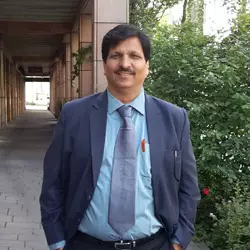A masterclass in sustainable profitability - The Noel D'Cunha Sunday Column
Three print heads – Vipul Arora of ITC, K Selvakumar of Lovely Offset Printers and Animesh Kejriwal of Parksons Graphics know that they have to up their game, in a world of printing where competition is hotting up. They know there are benefits of pursuing sustainable practices.
The three along with Sanjiv Kalra, business manager at Pidilite Industries share insights into their green strategies.
In this Sunday Column, we share these experts’ views on economic advantages of going gre
05 Aug 2017 | By Noel D'Cunha
“We may not be the best in protecting the environment, but we keep giving our best.” These are the words of K Selvakumar, director at of Lovely Offset Printers during the Pidilite-PrintWeek India Webinar on ‘Building a sustainable and green environment for packaging converters’.
Print CEOs across the Indian print fraternity are keen to grow but face a threat from falling profitability. All the reasons for the print industry need to take a look at the components that make the difference between shrinking margins and increased profitability.
There’s material cost, substrate, ink cost, the cost of building, heating and cooling and the electricity cost. Each one of these components needs to be looked at. “There’s a strong correlation between reducing cost and conservation resulting in savings, improving profits and being green. So it’s a double benefit,” says Animesh Kejriwal director at Parksons Graphics.
So, is sustainability a tool in competitive printing? How can we achieve the marriage between profitability while increasing the green scorecard?
By doing business the smart way, says Gavin Rittmeyer of Martin Automatic, with whom I discussed on the sidelines of LMAI Conference 2017 in Agra. Why are we in business, he asked? “If we are not making a profit, we are not able to carry on and do what we desire – personally, corporately or socially,” was his response.
The ITC’s approach towards sustainability is based on triple bottom line performance – which includes planet, people and finally profits.
In short, sustainable practices can help reduce costs (particularly energy expenditure), open up new markets and improve the company’s reputation. But how do we achieve this marriage between profitability while increasing our green scorecard?
Current landscape
Kejriwal says we hear about green, and it’s the buzz word in the market for some time now. “A lot of brands talk about it, a lot of companies mention it in their pitches. But honestly, it is very hard to pursue becoming green unless it’s economically viable.”

Vipul Arora, ITC
Vipul Arora, manager operations at ITC says sustainability in business is important and makes business sense. As all of us know, climate change is for real. “As per the Paris climate change agreement signed in May 2015, it entails sustainable development goals for each and everyone in the world. Climate change is something which is imminent with global warming being the immediate effect. The change in the climate is a complex and long term phenomena and effects of which are interrelated.”
The other trigger that pushes players to pursue green is market demand, like clients asking for certain certification or government pushing law enforcements.
In India green has to be taken with a pinch of salt – it’s a double-edged sword, says Kejriwal. “For example, we are an FSC certified company, that’s largely being eco-friendly. But at the same time, there comes a condition when we are forced to use backup power like a DG (diesel generator set), which is not an eco-friendly energy source. So you have to co-exist. As thing improves, we will be able to eliminate these things from our company.”
However, the government itself has started getting particular about implementing pollution control, and it’s time to start cleaning up.
Understand the importance
For any successful sustainability effort, the leader of the company has to understand what is right and act accordingly.
At Lovely Offset, Selvakumar says, protection of the environment is an integral part of its business ethics. “We try to operate in harmony with the environment, and to a great extent without disturbing the nature.”

K Selvakumar, Lovely Offset Printers
So when Lovely Offset acquired a 30-acre plot for a new plant in Sivakasi, the site had quite a number of trees. “While planning the buildings in the plant, we ensured that we cut the least amount of trees. And once we moved in, we planted new saplings to compensate for those we had to cut.”
Selvakumar adds, “Right from day one, we have clear-cut policies as far as sustainability is concerned. These include: usage of renewable energy, recycling, wastages, conservation and reducing carbon footprint.”
According to the reports shared by Arora, the company is the only one of its size that has been carbon positive for 11 years in a row, water positive for 14 years in a row, solid waste recycling positive nine years in a row. “All this is driven by our motto: A better tomorrow for all,” adds Arora.
Focus on your strength
Good performance in any organisation comes from concentrating on what that it does best. It is therefore important for companies to consider areas in sustainability where they can make the greatest impact.
At Parksons, the company looks at reducing consumption to reduce costs thereby becoming green by using fewer resources. “Our eventual goal is to be zero-waste producing company – that means you are effectively consuming everything you would have thrown out,” says Kejriwal.
He says it’s an iterative process that has been going on for some time. “There are three ways of doing it: increase efficiency by running a better, faster plant, where your per capita consumption is lower; reduce wastage, which saves energy and time; and increase recycling, where your waste output is put to use.”
It makes sense to conserve energy because it is one area where it pays.
In a typical factory environment, one sees energy wasted. For instance, we tend not to switch off the machine when not in use or switch off the UV lamps. “If your operators are trained in these small aspects of switching off the machine or UV lamps when it is not in use, it will help save lots of energy,” says Selvakumar.
Another area which is neglected in many factories is preventive maintenance – both electrical and equipment. “A few years ago we noticed our panel boards used to gather lots of dust which stayed there. This used to cause short-circuits and electrical breakdowns. Once we put a preventive maintenance system in place, we saw a 20% decrease in electrical breakdowns, and an equal percentage of savingsin cost that we spent on replacing those fused electrical fittings,” says Selvakumar.
Other ways of saving energy would be – constructing plants in such a way that there’s plenty of natural daylight entering the production and logistics area and using energy efficient fittings. Both Kejriwal and Selvakumar saytheir companies use LED fittings. “Even when we buy new equipment, one of the major criteria is energy efficiency,” they say.
Integrate sustainability into your business plan
The ad hoc approach to sustainability may not be a good idea, particularly in places where some problems are not new.
While power is a more expensive resource in terms of its cost, water is still not so much. “We all face drought situation or scarcity of water, for example, in Western India in 2015, there was a critical shortage of rain, leading to a shortage of water supply, almost 50% water cuts,” says Kejriwal. Using an STP (sewage treatment plant) or ETP (effluent treatment plant) and recycling treated water may be the way to go.
ITC generates about 400 lakh units in a year of electricity through wind energy. The energy is generated through the nine wind mills of 14.1 MW capacity installed at a site 300 km from Chennai. Arora says, “The total electricity generated is more than what is required by the Chennai plant. Hence ITC Chennai generally supplies excess renewable energy to TNEB (Tamil Nadu Electricity Board) grid to supply to other places.”
But for Sivakasi, which is called the Mecca of printing, it is by nature that the companies have to be conservative when it comes to using water and other natural resources. “Sivakasi is a dry place, and water is scarce throughout the year,” says Selvakumar. “We take great care when using water because for us water is a very precious commodity. Rains are scanty, and the groundwater is as low as 600 ft, with no assurance of a regular supply to the borewells.”
One of the most important aspects of conservation is Lovely’s investment in rain water harvesting. The company has built huge underground tanks and wells inside the factory, where the rain water is collected from the roof of its factory sheds, and channelised to a 3,00,000 litres capacity tank, wells and smaller pits.
Selvakumar says, “The benefit of rain harvesting has been the substantial increase in the groundwater levels, in the last four-five years. It has not only helped us, but also the communities surrounding our factory.”
An interesting project that ITC has undertaken was the use of AHU (air handling units) condensate to air condition most of the areas of the plant, which was earlier being wasted through the storm water drains. “By collecting the condensed moisture, we have been able to save 25,000 litres per day of water in Chennai and 13,000 litres per day in Haridwar which is about 13.8 million litres of water in a year,” informs Arora.
He adds, “The water from AHU’s is pure and one can collect it in a tank and use it for the processes where you need good quality water like the cooling tower, boiler, etc.”

Animesh Kejriwal, Parksons Graphics
Kejriwal goes a step further and says a lot of initiatives have been taken in the pre-press areas, where it is migrating to chemistry-free plates with the idea of lower water consumption because it enables the use of lesser chemicals. “The technology has been around for the last three-four years, but it is now that it is maturing in terms of providing quality as well as becoming economically viable when compared to the regular plates.”
There are two benefits. “One, you are eliminating the entire operation of the processor, and you also become greener. Most of the plate suppliers are in a position to supply these plates.”
Kejriwal feels that a large consumer of water is the bath in offset printing. He suggests that a delay or reducing the bath frequency by adding filtration can prolong the life of the conductivity. “Added benefit is that it will help reduce your press downtime, which means you are in a position to run the press more, produce more.”
A framework for measurement
If you have to reduce consumption, you will need some kind of framework for measurement that will tell you where you are. Many a time, we invest in the eco-friendly or energy efficient equipment but we don’t know what we have ended up with. Some of the measurement guidelines may not be the definite way of doing it, but what they do is give you a point to start with.“In order to achieve the sustainability goals and deriving economic gain one has to monitor and measure its environmental performance in terms of energy use, air emissions, water and waste management, sustainable use of raw materials used and finally biodiversity,” adds Arora. “ITC meets 40% of its energy needs from renewable energy. In terms of specific energy, we have achieved 4% year-on-year reduction, 13% in water reduction, 3% in waste reduction, 8% reduction in greenhouse gas emission.”
For example, we buy a five-star rated air conditioning unit instead of the one rated as a three- star. But at the end, we don’t know how much has been the saving, economically at least. Do we have a measurement to find out where it makes sense to buy the same one, if we have to make a repeat purchase? Kejriwal says, “Measurement helps you make a decision, and in future make more informed decisions.”
Parksons has plants in Daman, Navi Mumbai and one in Andheri. Not all of its plants have a clear framework for measurement. “But we do take a lot of initiatives where we do have a framework for measurements,” says Kejriwal.
Parksons has set up energy meters on all its panels across its entire department. And this can be done for water or waste. The readings are jotted and fed into a spread sheet which builds up the numbers automatically into a summary form providing the company with a department wise monthly data of consumption of energy units.
Kejriwal shared the chart of power units consumed for various operations. “The first step is to create this kind of framework and start looking for areas where we can improve. Now, this can be done by just looking at the numbers and going with the lowest hanging fruit or doing an energy audit and get inputs from a consultant on the areas which need to be improved.”
Kejriwal cites the compressor in the chart as an example. “If you look at the compressor, this is huge power consumption, and lots of people miss it when they are buying a compressor. This helped us identify that it’s a huge cost centre, and work on reducing that over time.”
It is however important that you convert your measurement to a ratio. One matrix to use is impression per printing unit. So the number of impressions we get per energy unit of power we consume or the number of impressions we get per air conditioning unit consumed, that’s your cooling efficiency. For a packaging unit, it could be the energy you consume divided by a number of tonnes of paperboard you convert. You can come up with your own matrix. “You need to devise your own ratios based on your working and then use that as an incentive to improve over time,” says Kejriwal.
The supply chain
For a business to survive, it’s strategic to have a business partnership with suppliers. That’s because we need to make smart decisions when: buying equipment or materials needed to produce a product.
Rittmeyer of Martin Automatic, says that you have to rely on your supply chain, and most of the time we will beat that guy down to lower the cost and not allow him to make money. “Is that a sustainable partnership?” he asks.
“It makes sense to understand your suppliers, because a poor performance by the supplier can ruin your business or on the other hand enhance your ability to deliver a profitable solution, which is also sustainable,” says Rittmeyer.
Kejriwal gives an example where suppliers can be of help. A lot of suppliers, he says, are now willing to take back raw material cans or containers, or even the plate suppliers now offer to take back the corrugated boxes in which the plates are supplied. “You can sit down and have these discussions with your suppliers, it’s a win-win situation for both.”
Rittmeyer feels a supplier is the one who does not trick you into buying something that is not good for your business. “It’s a complex view, but a worthy one to have.” Remember the 3E’s, he says, when you are buying an equipment or material. One is: is it easy to understand. Two, is it easy to operate. And third: easy to maintain.
In all three, you have to see if your operator can intuitively understand what’s going to move in the press or any other equipment even before they see a video or is trained; are they able to easily operate the equipment quickly, not take days and days.
“Everyone wants to control inputs to their business. So if you are able to keep the machine running, you are not just making a USD two or three million equipment running, but are actually increasing your profitability because of the ability of your operator to keep the machine running,” says Rittmeyer.
Reduction of finished material wastage
This can have a huge impact on your bottom line as well as how green you are.
Monitoring waste, and having a feedback on how you can estimate that waste better also helps reduce your finished material waste. “People have a thumb rule of 5% waste, which is added to your issued material. If you keep adjusting that waste to 4% or 3%, depending on your output, you would be able to improve that further. That can have a huge impact on how much waste you are throwing out each month and how much profit you are making.” Something worth looking into.
ITC has invested in a board waste compacting machine around five to six years ago. The result: it keeps the area clean, recycler can carry more waste per truck and finally improvement in truck load ability from four tonnes to eight tonnes per truck, reducing freight emissions by half. In addition, with its vermi-compost pit, it generates 6000kg of manure which is used for its consumption as well by ITC’s employees.
Engage your employees
It’s very important to engage with the employees when it comes to environmental conservation. There’s a need to constantly train employees to reduce wastage and conserve energy not only at work place but also at home, because it will save a lot of money for them.
Selvakumar says, “We make our employees aware of benefits of switching off lights when not needed, or even switching off air conditioners when not needed, and if possible switch it off at least 20-30 minutes before you get out of the conference/meeting room or offices.”
He says, “We celebrate environment week once a year, where people take a pledge to protect the environment.”
In Summary
In a maturing, evolving or upcoming economies, the growth rates are substantial – 12%, 18%, and more, year on year.
You are involved with expanding the capacities, and that’s great because there is more throughput.
But if you are 25% or more inefficient, you are not gaining on profitability. In a market that is growing so rapidly, it will keep you well.
But when the market slows down, and it can be for any reason like demonetisation, or the GST, or any other factor, and if you haven’t been efficient, it can become a dangerous proposition to your business.
Even growing markets go through phases where they slow down and not recover to where they were.
Going green will definitely make you more profitable. It’s about reducing consumption and a double benefit. You become more profitable and you become greener.
SanjivKalra, business manager at Pidilite Industries, the sponsor of PrintWeek India Packaging Converter of the Year 2017 Awards

Sanjiv Kalra, Pidilite Industries
Pidilite Industries has been one of the leaders in offering a range of adhesives with various technologies to the print industry. Pidilite has been catering to a range of segments like cigarette, paper converting, book binding, end-of-line packaging among others since more than five decades in India. The company known for brands like Fevicol, Dr Fixit, M-seal, and Fevikwik shared its range of 'go green' initiatives at the webinar.
Kalra shares the various technologies employed to develop safe and compliant products. He says, “At Pidilite, we put in a lot of effort in research and development to produce the range of safe products.”
“Green products are those which are non-combustible, non-toxic, recyclable and produce low or no carbon footprint. And one can take simple steps in order to be sustainable,” says Kalra.
To achieve its sustainability objective, Pidilite follows four basic principles - reduce pollution, conserve resources, conserve energy, and finally reduce consumption and waste. In the past few years, Pidilite has taken a slew of initiatives to achieve the go green objective by making compliant adhesives. He says, “At Pidilite we take into consideration all the factors while formulating the adhesives.”
Kalra informed, “For example, all the range of products are free of VOC (Volatile Organic Compound), a compound which affects the environment and harms the users. This has been achieved by steadily moving from solvent-based to solvent-free and water-based adhesives.”
Today, Pidilite’s water-based products based on EVA and Acrylic platforms have replaced solvent-based systems for flexible packaging. “The applications where it gets used successfully are – aluminium foil to paper and film to paper,” said Kalra.
In addition, Kalra explained how Pidilite products are benzene-free / toluene-free, adhesives are APEO free and is free of heavy metals. “Most of our products are REACH – a regulation of the European Union and EN71 (a set of European product safety standard regulations) compliant.”
Talking about the initiatives undertaken at Pidilite’s 22 manufacturing locations, Kalra said, “Each and every factory has an effluent treatment plant installed. Plus are fitted with chiller vent condensers provided to avoid solvent going into the atmosphere, and pulse jet dust collector installed in the boiler to protect the environment from suspended particulate matter (SPM) going into the atmosphere.”
“All our manufacturing locations are actively taking steps to work on the policy of 3R’s towards pollution and pollutants - Refuse, Reduce, Recycle,” concludes Kalra.











 See All
See All